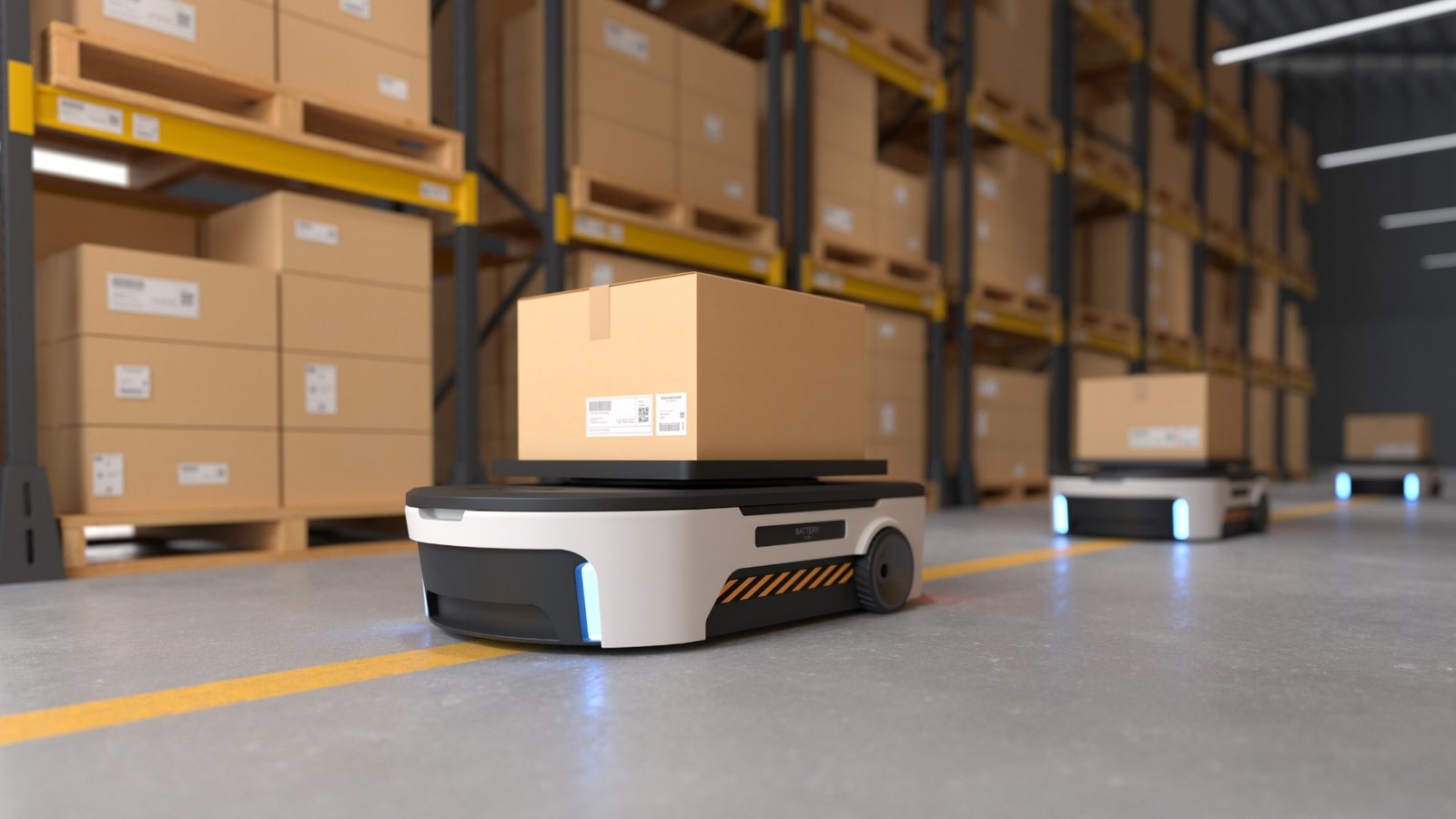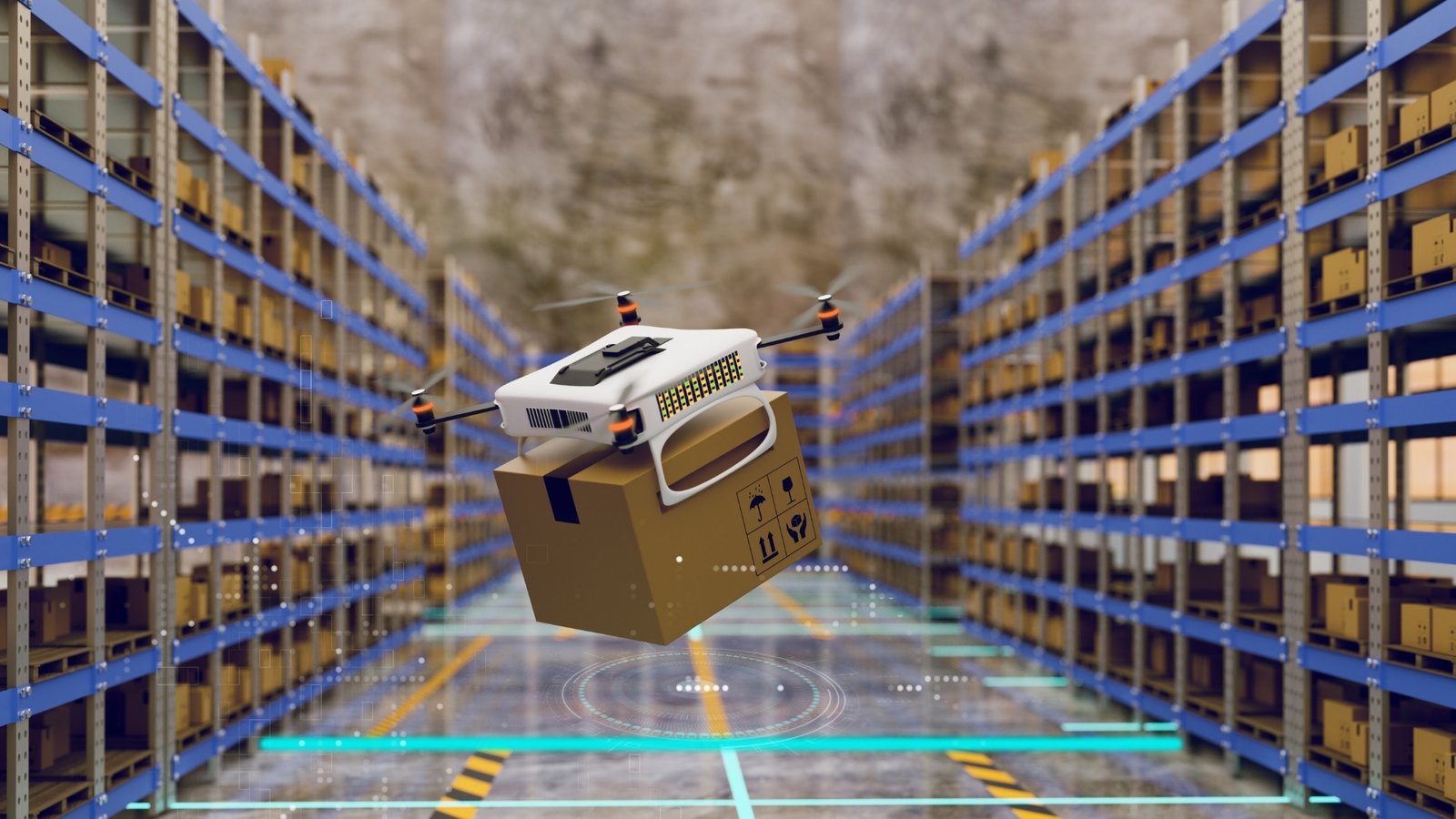Introduction to Automation in Logistics
Automation in logistics refers to the use of technology to perform tasks that traditionally required human intervention, thereby enhancing efficiency and accuracy in the supply chain. As logistics is a critical aspect of global commerce, the adoption of automation is transforming the way goods are stored, tracked, and transported. With the rapid advancements in technology, various tools and systems have emerged, resulting in a paradigm shift that responds to the growing demands of the market.
Key technologies driving automation in logistics include robotics, artificial intelligence (AI), Internet of Things (IoT), and advanced software systems. Robotics is commonly utilized in warehouses for order picking, sorting, and packing. These robotic systems not only reduce the time required to fulfill orders but also decrease the likelihood of errors, providing significant cost savings. On the other hand, AI applications optimize inventory management and transportation routes, allowing companies to make data-driven decisions that enhance operational efficiencies.
The significance of automation within the logistics sector cannot be overstated. With increasing competition and customer expectations for faster delivery times, businesses are compelled to reassess their operations. Automation presents a solution by streamlining numerous processes, leading to improved throughput and customer satisfaction. As companies strive to remain relevant and cost-effective, they are opting for automation as a strategic decision to optimize their resources and capabilities.
Furthermore, the current landscape of logistics is marked by the challenges brought on by the COVID-19 pandemic, which highlighted the need for scalable and resilient supply chains. Automation has proven to be a viable response to such challenges, ensuring business continuity and supporting growth in uncertain environments. Through the integration of automated systems, logistics firms can achieve greater agility, flexibility, and ultimately, a competitive edge in an ever-evolving marketplace.
Benefits of Automation in Logistics
Automation in logistics processes offers a multitude of advantages that drive efficiency, reduce costs, enhance accuracy, and improve customer service. By integrating automated systems into logistics operations, businesses can streamline their workflows, thereby enabling a faster and more reliable transportation of goods.
One of the primary benefits of automation is the significant increase in operational efficiency. Automated systems, such as warehouse management software and robotic process automation, can handle repetitive tasks like inventory tracking and order fulfillment at a much faster rate than manual processes. For example, the implementation of automated picking systems in warehouses has shown to reduce order processing times, allowing companies to respond quickly to market demands and enhancing their service levels.
Cost savings is another significant advantage that automation brings to logistics. By reducing the need for manual labor and minimizing human errors, companies can lower their operational costs. For instance, automated transport management systems enable optimization of shipping routes, which not only saves fuel but also reduces overall transportation expenses. Furthermore, these systems can forecast demand better, leading to improved inventory management and reduced holding costs.
Enhanced accuracy is a critical aspect of logistics that can be dramatically improved through automation. Automated data collection tools, such as barcode scanners and RFID technology, minimize errors associated with manual entry, ensuring that inventory counts and order details are precise. This accuracy directly translates to higher customer satisfaction, as consumers benefit from reduced mistakes, timely deliveries, and accurate tracking of their shipments.
Finally, automation contributes significantly to improved customer service. With real-time tracking capabilities and automated notifications, customers can receive updates regarding their orders, thus enhancing their overall experience. By providing timely information and reliable delivery schedules, businesses can foster customer loyalty and gain a competitive edge in the market.
Key Technologies Enabling Automation
In the ever-evolving landscape of logistics, several key technologies have emerged that are pivotal in enabling automation and enhancing operational efficiency. These technologies range from sophisticated software solutions to innovative hardware devices, each playing a unique role in streamlining logistics processes.
Warehouse Management Systems (WMS) are integral to modern logistics. They facilitate real-time tracking of inventory, provide insights into stock levels, and optimize the picking and packing processes. By automating these tasks, WMS improve accuracy and reduce the time taken to fulfill orders, thus driving productivity. As a result, companies can better manage their supply chains and respond swiftly to market demands.
Automated Guided Vehicles (AGVs) stand out as another critical technology. These mobile robots are designed to transport goods within warehouses and manufacturing facilities without human intervention. By navigating predefined routes using sensors and software, AGVs not only enhance safety but also ensure that goods are moved efficiently around the facility, minimizing the potential for delays and accidents.
Robotics, particularly in picking and packing applications, has also significantly transformed logistics. Robotic arms capable of identifying and handling various products streamline the sorting process, while collaborative robots (cobots) work alongside human operators to tackle repetitive tasks. This technology reduces labor costs and increases throughput, allowing organizations to allocate human resources to more complex and value-added activities.
The Internet of Things (IoT) is becoming increasingly relevant in logistics automation. IoT devices, such as sensors and RFID tags, monitor equipment and inventory in real-time, generating actionable insights for logistics managers. This connectivity leads to improved supply chain visibility, enabling proactive decision-making and efficient asset management.
Artificial Intelligence (AI) further amplifies these technologies by employing predictive analytics to forecast demand, optimize routes, and enhance customer service. AI’s ability to analyze enormous datasets allows firms to fine-tune their logistics operations continuously, leading to better resource allocation and cost savings.
The integration of WMS, AGVs, robotics, IoT, and AI creates a robust framework for automation in logistics. These technologies work in concert to not only improve efficiency and productivity but also to lay the groundwork for a more responsive and agile logistics environment.
Challenges in Implementing Automation
Integrating automation into logistics processes presents a range of challenges that companies must carefully navigate to achieve successful implementation. One of the foremost hurdles is the high initial costs associated with acquiring advanced technology and systems. Investments in automation tools, robotics, and software platforms can be substantial, prompting organizations to reevaluate their budgets and funding strategies. This financial burden may deter many firms, particularly smaller enterprises, from pursuing automation initiatives that could otherwise enhance efficiency and operational capability.
Another significant challenge is the inherent resistance to change from employees. The introduction of automated systems often generates apprehension among staff members who may fear job displacement or adjustments in their daily responsibilities. Cultivating an organizational culture that embraces technological advancements is crucial. Companies need to communicate the benefits of automation clearly, emphasizing how these tools can empower employees to focus on higher-value tasks and improve overall productivity.
Additionally, the need for ongoing maintenance and updates adds complexity to the adoption of logistics automation. Automated systems require regular check-ups, software upgrades, and troubleshooting to ensure optimal performance. Organizations must allocate resources and skilled personnel to manage these technical demands, as neglecting maintenance can lead to operational disruptions that negate the advantages gained through automation.
To successfully address these challenges, strategic planning and comprehensive training programs are essential. Stakeholders should develop clear objectives for automation implementation and engage all relevant departments in the planning process. Providing ongoing training and support for employees will also be vital in facilitating a smoother transition. By prioritizing these elements, companies can mitigate resistance and maximize the benefits of automating their logistics operations, driving efficiency and competitive advantage in the long run.
Case Studies of Successful Automation in Logistics
Automation has significantly transformed logistics processes across various sectors, with businesses consistently seeking innovative solutions to address operational challenges. One notable case study is that of Amazon, which has integrated automation through robotics in its fulfillment centers. Faced with increasing demand and the need for rapid delivery, Amazon adopted Kiva robots to manage inventory and streamline sorting processes. This shift not only improved the speed of order fulfillment but also enhanced accuracy, reducing human error. As a result, Amazon reported a notable decrease in operational costs and a remarkable improvement in delivery speed, fortifying its position as a leader in logistics.
Another exemplary case is the multinational company DHL, which implemented automated sorting systems in its warehouses. The firm faced the challenges of managing diverse inventory and insufficient sorting speed to meet customer expectations. By utilizing advanced conveyor systems coupled with machine learning algorithms, DHL was able to optimize package sorting. This automation reduced processing times and increased throughput significantly, ultimately leading to a measurable improvement in customer satisfaction rates. Moreover, the return on investment was seen in terms of reduced labor costs, as the reliance on manual sorting diminished considerably.
Furthermore, UPS illustrates a successful automation strategy through its Package Flow Technology. The company experienced bottlenecks in tracking and delivery due to increasing package volumes. By automating package tracking and integrating real-time data analytics into its logistics processes, UPS enhanced its delivery efficiency. The outcome was evident as operational costs decreased while service reliability improved. Through these case studies, it becomes clear that automation in logistics not only addresses immediate challenges but also lays the foundation for sustainable growth and operational success. Each of these companies showcases the importance of adopting intelligent automation solutions in enhancing the dynamics of logistics processes.
The Future of Automation in Logistics
The logistics industry is on the cusp of a significant transformation, driven largely by advancements in automation technology. As the demand for faster, more efficient supply chain solutions escalates, the role of automation in logistics is expected to expand. One of the most exciting predictions is the rise of fully automated warehouses, where robotic systems take over tasks such as inventory management, order fulfillment, and shipping preparation. These automated operations promise to reduce human error, lower labor costs, and improve overall efficiency.
Additionally, enhanced data analytics will play a crucial role in shaping the future of automated logistics. By leveraging big data and machine learning algorithms, companies can analyze vast amounts of information to forecast demand more accurately, optimize delivery routes, and streamline inventory management. This data-driven approach not only enhances decision-making processes but also ensures a more responsive supply chain, capable of adapting to changing market conditions.
Moreover, regulatory changes are poised to impact the adoption of automation in logistics. As governments worldwide prioritize supply chain resilience and sustainability, regulations related to data privacy, environmental impact, and workforce transition will emerge. Organizations that align their automation strategies with these regulations will likely gain a competitive advantage, as they will be better positioned to meet compliance requirements while reaping the benefits of increased productivity.
Another trend to anticipate is the integration of artificial intelligence (AI) in logistics processes. AI-powered systems can facilitate predictive maintenance on machinery, optimize shipping schedules, and improve customer service through automated support solutions. As AI continues to evolve, its applications in logistics will further enhance operational efficiencies and provide firms with the agility required to compete in a rapidly changing marketplace.
Collectively, these trends highlight a future where automation is not merely a tool for efficiency but a foundational element of modern logistics, reshaping how businesses operate and deliver value to customers.
Building a Roadmap for Automation Adoption
As businesses explore the integration of automation into their logistics processes, developing a comprehensive roadmap is crucial for a successful adoption. The first step in this roadmap is conducting a thorough needs assessment. This involves evaluating the current logistics workflows to identify inefficiencies and bottlenecks. By pinpointing specific areas where automation can make a significant impact, companies can create a clear vision of the improvements sought through automation.
Next, businesses should establish clear and measurable goals for their automation initiatives. These goals should be aligned with overall business objectives, ensuring that automation efforts support the larger vision of the organization. For example, a company aiming to enhance customer service may prioritize logistics automation solutions that optimize delivery times and improve order accuracy. Setting specific targets allows businesses to track progress and adjust strategies as needed.
Once the needs assessment and goal setting are complete, it is essential to select the appropriate technologies that will facilitate the desired automation outcomes. This could encompass various solutions ranging from automated inventory management systems to AI-driven forecasting tools. Evaluating the compatibility of these technologies with existing processes is important. Engaging with technology providers and conducting pilot tests can provide valuable insights into the effectiveness of chosen solutions.
The final step in this roadmap involves measuring the success of automation adoption. Key performance indicators (KPIs) should be developed to evaluate the impact of automation on logistics processes. Metrics such as cost savings, reduction in order processing times, and improved accuracy can help businesses understand the return on investment for their automation efforts. Regular reviews of these metrics will provide feedback on the effectiveness of the chosen strategies and guide future improvements.
Measuring the Impact of Automation
As businesses increasingly integrate automation into their logistics processes, measuring its impact becomes crucial for assessing effectiveness and guiding future strategies. Various methods and key performance indicators (KPIs) can provide insights into how automation influences operational efficiency, cost reduction, customer satisfaction, and error rates.
One fundamental approach to measuring impact is through efficiency metrics, such as order fulfillment time and inventory turnover rates. By automating warehousing tasks, companies can significantly reduce the time it takes to pick, pack, and ship orders, consequently improving overall turnaround times. Tracking these efficiency metrics enables organizations to pinpoint how automation tools, such as robotic systems and automated scheduling software, enhance performance over traditional methods.
Cost reduction is another critical area where automation’s impact can be quantified. Businesses can analyze operational expenses before and after implementing automated solutions to determine monetary savings related to labor, materials, and distribution costs. KPIs such as cost per order and cost per unit shipped can provide valuable comparisons that highlight the financial benefits of automation.
Customer satisfaction is essential; therefore, businesses should monitor KPIs like order accuracy and delivery time reliability. Improved accuracy rates often result from automated processes that minimize human error. Utilizing customer feedback and satisfaction surveys alongside tracking metrics like Net Promoter Score (NPS) can offer qualitative insights into how automation affects customer experiences.
Lastly, businesses should evaluate error rates, examining categories like shipping errors and inventory discrepancies. By implementing automated systems, organizations can frequently see a reduction in these errors, leading to less rework and higher customer trust. Overall, by employing these methods and KPIs, businesses can effectively measure the impact of automation and make necessary adjustments to optimize logistics processes for continued success.
Conclusion: Harnessing the Power of Automation
As we have explored throughout this discussion, automation plays a crucial role in streamlining logistics processes, fundamentally transforming the industry. From improving operational efficiency to reducing human error, the advantages of incorporating automated systems are numerous. By leveraging advanced technologies such as artificial intelligence, data analytics, and robotics, businesses can optimize their supply chain management, enhance inventory control, and ensure timely delivery of goods.
The logistics sector is experiencing unprecedented change driven by shifting consumer demands and technological advancements. Companies that adopt automation stand to benefit from increased productivity. Automated processes minimize the time required for manual tasks and enable workers to focus on more strategic activities, thereby fostering a culture of innovation. In addition, automation can lead to significant cost reductions, as it allows businesses to maximize resource allocation and streamline operations. This not only enhances profitability but also strengthens competitive advantage.
Moreover, the ongoing evolution of logistics necessitates a forward-thinking approach. The implementation of automated systems not only prepares businesses for current challenges but also positions them for future growth. Organizations are encouraged to adopt automation not merely as a short-term solution but as a long-term strategy that can drive continuous improvement. While the transition may require initial investment and adjustment, the long-lasting benefits of enhanced efficiency and reliability underscore the importance of taking action now.
In conclusion, as the logistics landscape continues to evolve, embracing automation is not just an option but a necessity. Businesses that recognize the transformative potential of automation will be better equipped to navigate the complexities of supply chain management, ultimately leading to sustainable success and increased customer satisfaction.







